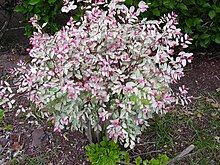Breynia
| Breynia | |
|---|---|

| |
| Breynia disticha | |
| Scientific classification | |
| Kingdom: | |
| (unranked): | |
| (unranked): | |
| (unranked): | |
| Order: | |
| Family: | |
| Tribe: | |
| Subtribe: | |
| Genus: | Breynia J.R.Forst. & G.Forst. 1776
|
| Synonyms[1] | |
Breynia is a plant genus in the family Phyllanthaceae, first described as a genus in 1776. It is native to Southeast Asia, China, the Indian Subcontinent, Papuasia, Australia, and the island of Réunion.[1]
The name Breynia is a conserved name, in other words, it is recognized despite the existence of an earlier use of the same name to refer to a different plant. Breynia L. 1753 is in the Capparaceae, but it is a rejected name. We here discuss Breynia J.R.Forst. & G.Forst. 1776.[2]
Breynia are of note in the fields of pollination biology and coevolution because they have a specialized mutualism with moths in the genus Epicephala (leafflower moths), in which the moths actively pollinate the flowers—thereby ensuring that the tree may produce viable seeds—but also lay eggs in the flowers' ovaries or in the space between the tepals and the carpel walls, from where their larvae consume a subset of the developing seeds as nourishment.[3][4] Other species of Epicephala are pollinators, and in some cases, non-pollinating seed predators, of certain species of plants in the genera Phyllanthus[5][6] and Glochidion,[7][8][9] both closely related to Breynia.[10] This relationship is similar to those between figs and fig wasps and yuccas and yucca moths.
- Species[1]
- Breynia baudouinii Beille – Vietnam
- Breynia calcarea (M.R.Hend.) Welzen & Pruesapan – W Malaysia
- Breynia carnosa Welzen & Pruesapan – Vietnam
- Breynia cernua (Poir.) Müll.Arg. – Northern Territory of Australia, New Guinea, Solomon Islands, Sulawesi, Philippines, Borneo, Java
- Breynia collaris Airy Shaw – Papua New Guinea
- Breynia coriacea Beille – Vietnam
- Breynia coronata Hook.f. – Thailand, W Malaysia, Borneo, Sumatra
- Breynia discigera Müll.Arg. – Thailand, W Malaysia, Sumatra
- Breynia disticha J.R.Forst. & G.Forst. – Vanuatu, New Caledonia; naturalized in West Indies, Florida, Gambia, and scattered oceanic islands
- Breynia diversifolia Beille – Vietnam
- Breynia fleuryi Beille – Vietnam
- Breynia fruticosa (L.) Müll.Arg. – Vietnam, Thailand, S China
- Breynia glauca Craib – Thailand, Myanmar, Laos, Borneo
- Breynia grandiflora Beille – Vietnam
- Breynia heyneana J.J.Sm. – Lesser Sunda Islands in Indonesia
- Breynia indosinensis Beille – Vietnam, Laos
- Breynia lithophila Welzen & Pruesapan – Thailand
- Breynia massiei Beille – Laos
- Breynia microphylla (Kurz ex Teijsm. & Binn.) Müll.Arg. – Sumatera, Java, Sulawesi
- Breynia mollis J.J.Sm. – New Guinea
- Breynia oblongifolia (Müll.Arg.) Müll.Arg. – Papua New Guinea, Queensland, New South Wales, Northern Territory
- Breynia obscura Welzen & Pruesapan – W Malaysia
- Breynia platycalyx Airy Shaw – W New Guinea
- Breynia podocarpa Airy Shaw – Papua New Guinea, Northern Territory
- Breynia pubescens Merr. – Maluku
- Breynia racemosa (Blume) Müll.Arg. – Andaman & Nicobar Islands, Thailand, Myanmar, W Malaysia, Sumatra, Java, Lesser Sunda Islands, Philippines, New Guinea, Bismarck Archipelago
- Breynia repens Welzen & Pruesapan – Thailand
- Breynia retusa (Dennst.) Alston – Réunion, India, Tibet, Sri Lanka, Nepal, Bhutan, E Himalayas, Myanmar, Thailand, Vietnam, W Malaysia
- Breynia rhynchocarpa Benth. – Northern Territory of Australia
- Breynia rostrata Merr. – Vietnam, S China
- Breynia septata Beille – Vietnam
- Breynia stipitata Müll.Arg. – Northern Territory, Queensland
- Breynia subangustifolia Thin – Vietnam
- Breynia subindochinensis Thin – Vietnam
- Breynia tonkinensis Beille – Vietnam
- Breynia vestita Warb. – New Guinea, Kai Island in Maluku Province of Indonesia
- Breynia virgata (Blume) Müll.Arg. – Sumatra, Java, Lesser Sunda Islands
- Breynia vitis-idaea (Burm.f.) C.E.C.Fisch. – China, Ryukyu Islands, Taiwan, Indochina, Andaman & Nicobar Islands, India, Bangladesh, Pakistan, Sri Lanka, W Malaysia, Sumatra, Philippines
- Formerly included
Breynia subterblanca (C.E.C.Fisch.) C.E.C.Fisch, synonym of Sauropus subterblancus (C.E.C.Fisch.) Welzen[11]
References
- ^ a b c "World Checklist of Selected Plant Species".
- ^ Govaerts, R., Frodin, D.G. & Radcliffe-Smith, A. (2000). World Checklist and Bibliography of Euphorbiaceae (and Pandaceae) 1-4: 1-1622. The Board of Trustees of the Royal Botanic Gardens, Kew.
- ^ Kawakita, A.; Kato, M. 2004. Obligate pollination mutualism in Breynia (Phyllanthaceae): further documentation of pollination mutualism involving Epicephala moths (Gracillariidae). American Journal of Botany. 91: 1319–1325.
- ^ Zhang, J.; Wang, S.; Li, H.; Hu, B.; Yang, X.; Wang, Z. 2012. "Diffuse coevolution between two Epicephala species (Gracillariidae) and two Breynia species (Phyllanthaceae). PLOS ONE. 7: e41657.
- ^ Kawakita, A.; Kato, M. 2004. "Evolution of obligate pollination mutualism in New Caledonian Phyllanthus (Euphorbiaceae)." American Journal of Botany 91: 410–415.
- ^ Kawakita, A.; Kato, M. 2009. "Repeated independent evolution of obligate pollination mutualism in the Phyllantheae-Epicephala association." Proceedings of the Royal Society B. 276: 417–426.
- ^ Kato, M.; Takimura, A.; Kawakita, A. (2003) "An obligate pollination mutualism and reciprocal diversification in the tree genus Glochidion (Euphorbiaceae)." Proceedings of the National Academy of Sciences of the USA. 100 (9): 5264–5267
- ^ Hembry, D. H.; Okamoto, T.; Gillespie, R. G. (2012) Repeated colonization of remote islands by specialized mutualists. Biology Letters. 8: 258–261.
- ^ Luo, S.-X.; Yao, G.; Wang, Z.; Zhang, D.; Hembry, D. H. (2017) "A novel, enigmatic basal leafflower moth lineage pollinating a derived leafflower host illustrates the dynamics of host shifts, partner replacement, and apparent co-adaptation in intimate mutualisms." The American Naturalist. 189: 422–435.
- ^ Kathriarachchi, H.; Samuel, R.; Hoffmann, P.; Mlinarec, J.; Wurdack, K. J.; Ralimanana, H.; Stuessy, T. F.; Chase, M. W. 2006. "Phylogenetics of tribe Phyllantheae (Phyllanthaceae: Euphorbiaceae sensu lato) based on nrITS and plastid matK DNA sequence data." American Journal of Botany. 93: 637–655.
- ^ Kew World Checklist of Selected Plant Families, Breynia subterblanca
